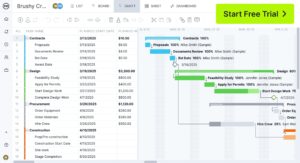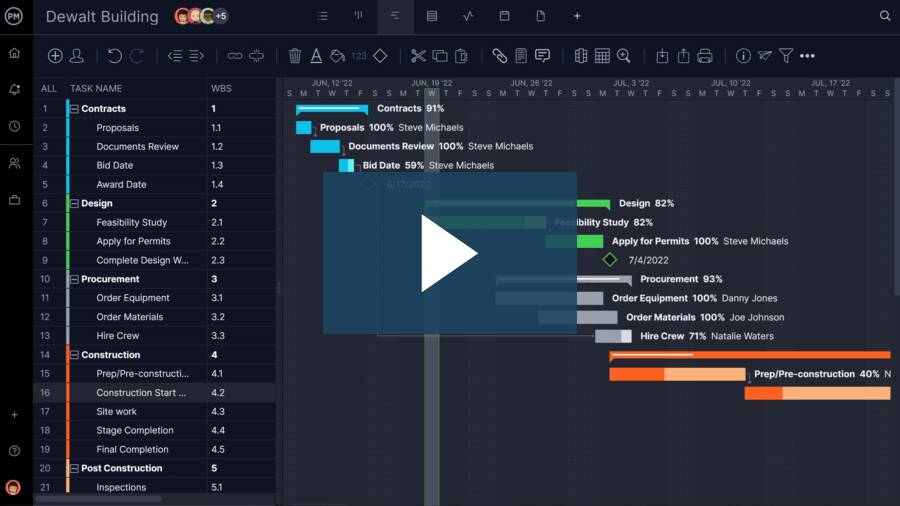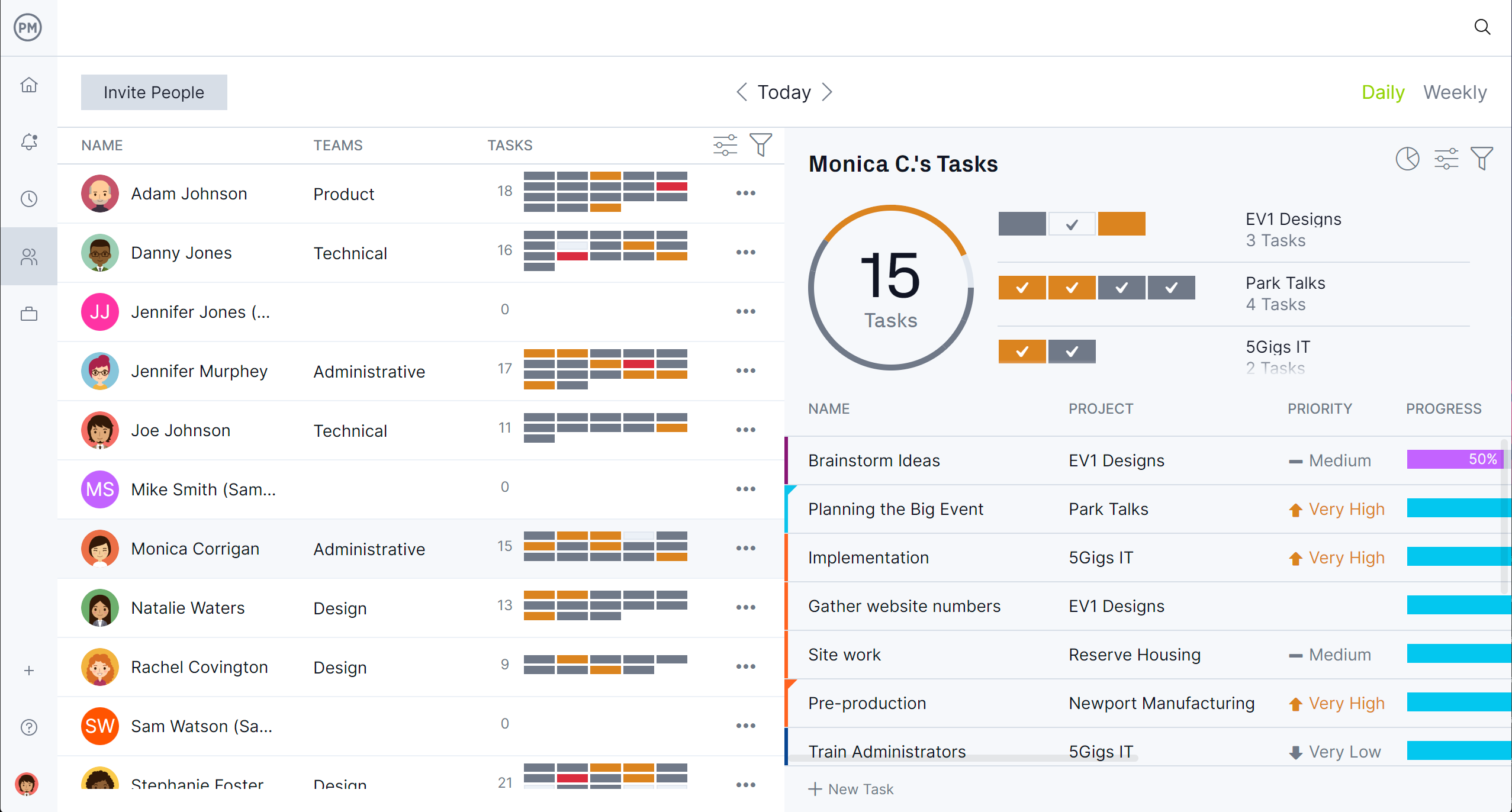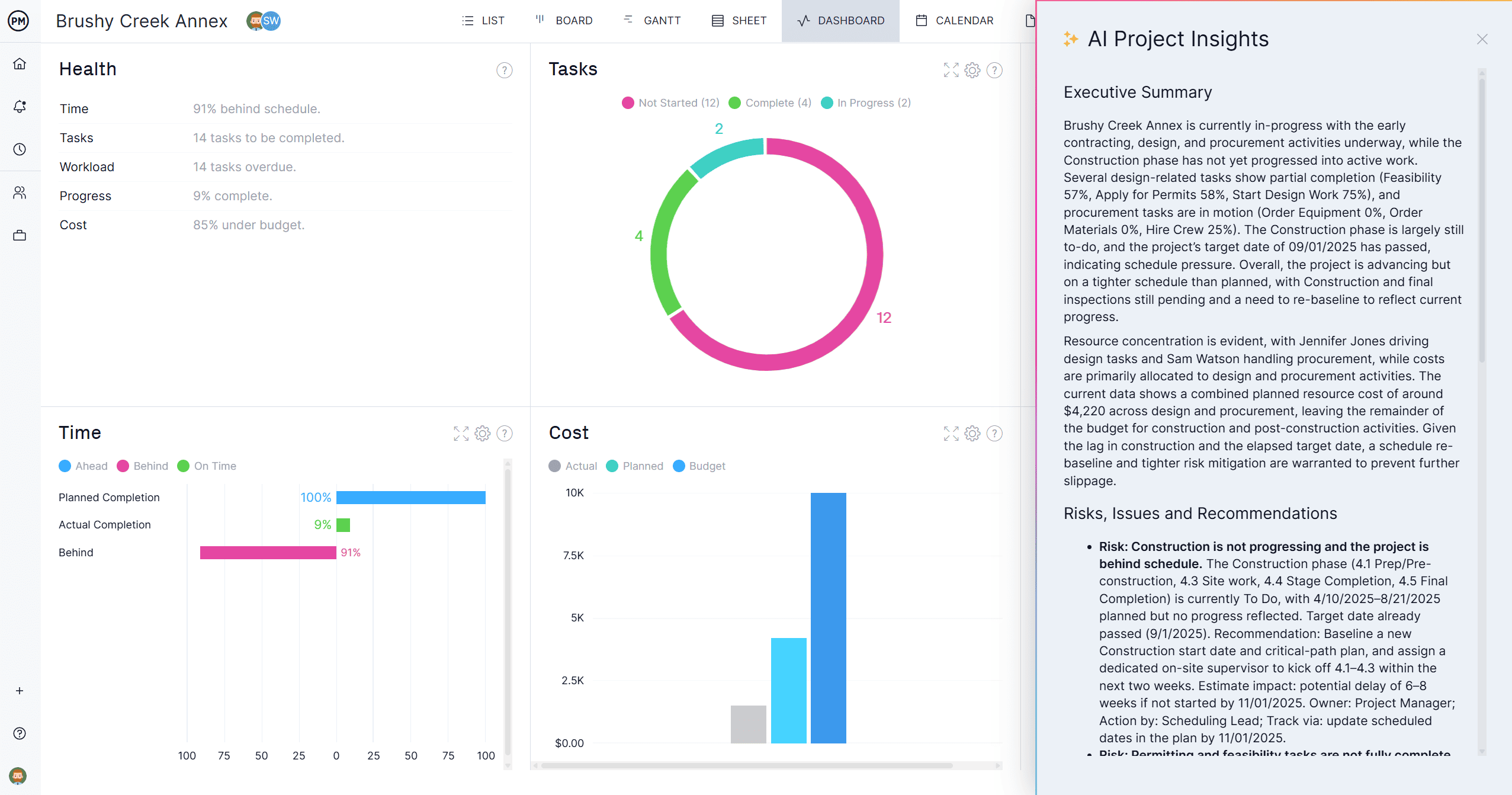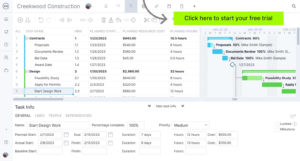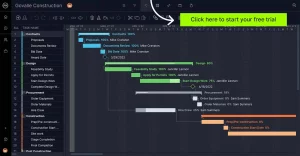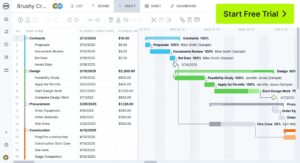Learning how to manage a construction company requires a clear understanding of the many moving parts in the business. To help you succeed, we’ve identified nine key areas that every construction company needs to manage effectively.
From project management and financial oversight to workforce and safety compliance, focusing on these areas ensures smooth operations, higher profitability and better client satisfaction. This guide breaks down each area with practical steps and strategies you can implement immediately.
1. Project Management
Effective project management is the backbone of any construction company. Managing projects successfully requires clear planning, scheduling, monitoring and coordination with all stakeholders. By streamlining project workflows and tracking progress, construction managers can reduce delays, control costs and improve quality. This area also involves risk assessment, resource allocation and effective communication to keep everyone aligned on project objectives. Strong project management ensures that projects are delivered on time, within budget and to the client’s satisfaction.
Project management software is essential to managing a construction project because it centralizes planning, execution and monitoring in one accessible platform. Construction projects involve multiple teams, subcontractors and suppliers, as well as complex schedules, budgets and regulatory requirements. Software helps coordinate these moving parts by providing tools for task assignment, timeline visualization, resource allocation and real-time progress tracking. It reduces errors, improves communication and ensures that everyone is aligned with project goals. Additionally, features like reporting, dashboards, document management and mobile access allow managers to make informed decisions quickly and control costs, ultimately increasing the likelihood of project success.
ProjectManager is ideal for managing construction projects because it combines planning, scheduling and collaboration tools in one platform. Its intuitive Gantt charts, real-time dashboards and task-tracking features make it easy to plan, execute and monitor progress while also allocating resources efficiently. The software also allows teams to update timesheets on-site through its mobile app, track labor costs and quickly respond to changes. With robust AI-powered reporting and integration options, our software helps construction companies stay organized, maintain accountability and deliver projects successfully from start to finish. Get started with ProjectManager today for free.
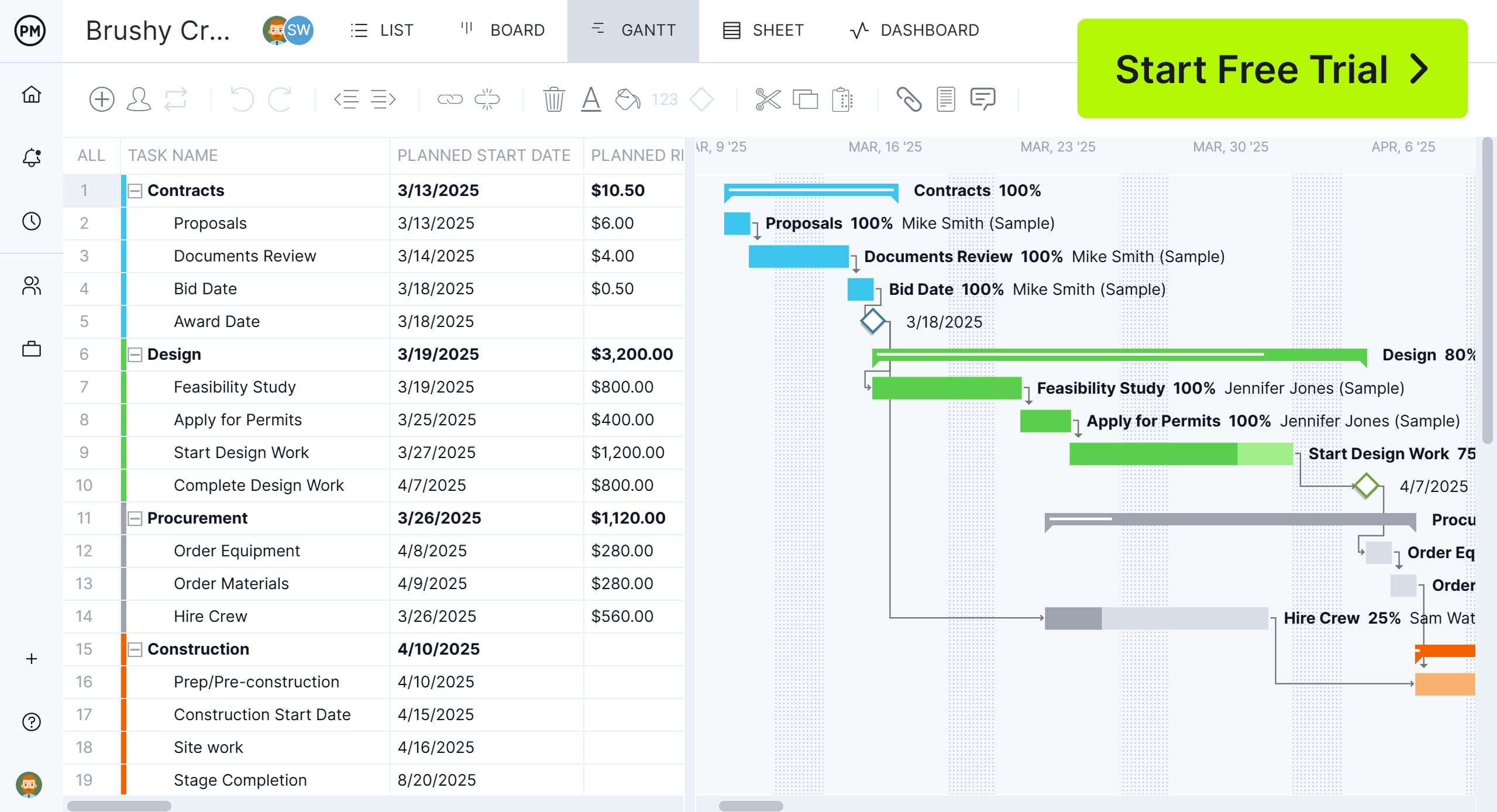
Planning, Scheduling and Monitoring Projects
Planning, scheduling and monitoring projects is essential to keep construction work on track. It involves creating detailed project plans, assigning resources and setting timelines for tasks. Continuous monitoring allows managers to adjust for delays, manage risks and optimize productivity. Using tools like Gantt charts, calendars and reporting dashboards ensures that projects stay organized and progress is visible to all stakeholders. Well-planned projects also reduce costly errors, improve team accountability and enhance client confidence.
Managing Contracts With Suppliers and Subcontractors
Managing contracts effectively ensures that suppliers and subcontractors meet deadlines, quality standards and budget expectations. This includes negotiating terms, monitoring performance and addressing disputes promptly. Clear contracts prevent misunderstandings and create accountability, which is crucial for maintaining smooth project workflows. Regular communication, progress tracking and compliance checks help construction companies maintain strong relationships and avoid costly delays.
Implementing Construction Project Management Software
Construction project management software streamlines planning, scheduling, budgeting and communication. It centralizes project data, provides real-time updates and enables collaboration between teams, subcontractors and clients. Features such as task tracking, reporting dashboards and document management help reduce errors and improve efficiency. Adopting the right software allows managers to focus on decision-making while maintaining control over multiple projects simultaneously.
Related: 20 Best Construction Scheduling Software of 2025 (Free & Paid)
Setting Up and Managing Construction Sites
Efficiently setting up and managing construction sites is critical to safety, productivity and cost control. This involves organizing storage areas, ensuring equipment is available and maintained and establishing workflows for crews. A well-managed site minimizes downtime, prevents accidents and ensures that materials and labor are used efficiently. Daily inspections, safety checks and communication routines help maintain order and keep projects moving smoothly.
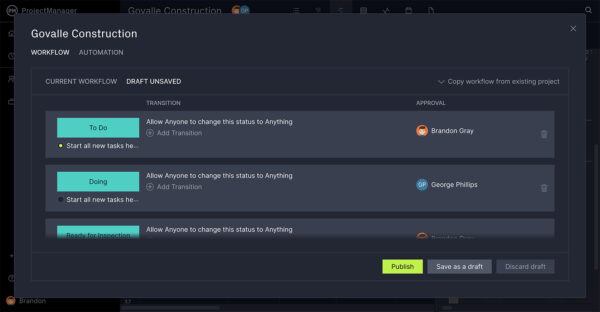
2. Business Strategy Planning
A strong business strategy ensures long-term growth and resilience. It involves defining your company’s mission, vision and objectives and aligning them with market opportunities. Effective strategy planning helps companies anticipate economic shifts, respond to industry trends and make informed decisions. By regularly revisiting and adjusting your strategy, construction companies can stay competitive and achieve sustainable growth.
Defining the Company’s Business Model
Defining your business model clarifies how your company generates revenue, delivers services and differentiates itself from competitors. This includes identifying target markets, core services, pricing strategies and operational processes. A clear business model provides a roadmap for decision-making and helps align resources toward achieving company goals.
Positioning the Brand
Brand positioning shapes how clients, partners and the public perceive your company. It includes defining unique selling points, marketing messages and visual identity. A strong brand builds trust, attracts new clients and supports long-term business development in a competitive construction market.
Adjusting to Changes in the Economy
Economic shifts impact material costs, labor availability and project demand. Companies must monitor economic trends and adapt strategies accordingly, whether through budgeting adjustments, diversifying services or exploring new markets. Proactive adjustments help maintain profitability and reduce risks during economic downturns.
Adjusting to Changes in the Market
Market trends, competition and client expectations constantly evolve. Staying attuned to these changes allows construction companies to innovate, offer new services and remain relevant. Market analysis, client feedback and competitive benchmarking inform decisions that improve positioning and growth potential.
3. Financial Management
Financial management ensures that the company remains solvent, profitable and sustainable. It involves budgeting, tracking cash flow, managing investments and evaluating project costs. Strong financial oversight helps construction companies plan for growth, weather economic fluctuations and maintain client trust through reliable billing and payment systems.
Securing Financing
Securing financing is essential for project execution, equipment purchase and expansion. This can involve loans, lines of credit or investor funding. Reliable financing ensures projects start on time and operations run smoothly, without interruptions due to cash shortages.
Managing Cash Flows
Cash flow management involves monitoring income and expenses to ensure liquidity. Construction companies must plan for payroll, material costs and unexpected expenses. Efficient cash flow practices prevent project delays and support long-term financial stability.
Related: 13 Budget Templates for Business & Project Budgeting
Establishing Guidelines for Estimating and Budgeting
Standardized guidelines for estimating and budgeting ensure projects are financially viable. Accurate estimates reduce the risk of cost overruns, support competitive bidding and provide a framework for managing project finances effectively.
Mastering Construction Bidding
Mastering bidding involves preparing competitive proposals that balance profitability and client expectations. Understanding market rates, project scope and cost structures helps construction companies win contracts while maintaining margins.
Keeping Operational and Overhead Costs Low
Controlling operational and overhead costs maximizes profitability. This includes optimizing labor, equipment usage, material procurement and administrative expenses. Efficient operations allow the company to invest in growth and improve competitiveness.
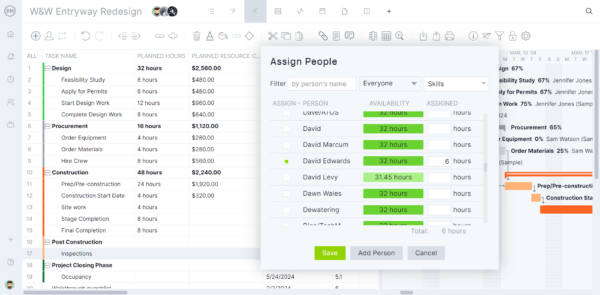
4. Construction Operations Management
Operations management covers the day-to-day execution of construction projects. It focuses on logistics, material handling, equipment management and standardizing processes. Streamlined operations increase efficiency, reduce waste and improve overall project quality.
Logistics and Supply Chain Management
Efficient logistics ensure timely delivery of materials and equipment. Supply chain planning reduces delays, lowers costs and maintains project momentum. Tracking shipments, coordinating vendors and planning inventory levels are essential for smooth operations.
Material and Equipment Storage
Proper storage of materials and equipment prevents damage, loss and theft. Organized storage areas improve site safety, reduce retrieval time and maintain equipment functionality.
Standardizing Operational Business Processes
Standardized processes ensure consistency, efficiency and accountability. Clear procedures for task execution, reporting and quality checks help teams work cohesively and minimize errors.

5. Safety & Compliance
Safety and compliance protect workers, the public and the company from legal and financial risks. Adhering to regulations and establishing internal safety standards ensures a safer work environment and project success.
Related: Free Construction Safety Plan Template
Ensuring Compliance with Occupational Safety and Health Administration (OSHA)
Compliance with OSHA regulations prevents workplace accidents and fines. Regular inspections, hazard assessments and safety programs keep the company aligned with federal safety standards.
Creating Safety Training Materials and Resources for Employees
Training materials educate employees on best practices, hazard recognition and emergency response. Well-prepared staff contribute to a safer site and reduce the likelihood of accidents.
Complying With Building and Zoning Codes
Adhering to building and zoning codes ensures legal compliance, smooth inspections and project approval. It protects the company from penalties and project delays.
Complying With Environmental Laws and Guidelines
Environmental compliance prevents fines and promotes sustainability. This includes managing waste, controlling emissions and following local environmental regulations.
6. Client Relations & Business Development
Building strong relationships with clients, suppliers and partners drives growth. Effective communication, networking and strategic alliances help construction companies secure new projects and maintain a positive reputation.
Establishing Customer Relationship Management (CRM) Guidelines, Procedures and Systems
CRM systems organize client information, track project interactions and improve communication. Structured procedures help maintain long-term client relationships and repeat business.
Establishing Alliances With Suppliers and Other Construction Firms
Strategic alliances provide access to resources, expertise and collaborative opportunities. Strong partnerships ensure reliable supply chains and expanded project capabilities.
Marketing and Networking Activities for Securing New Projects
Marketing campaigns, networking events and industry participation help attract new clients. Active promotion builds visibility, credibility and opportunities for future contracts.
7. Workforce Management & HR
A skilled and motivated workforce is critical for project success. HR management includes recruiting, training, scheduling and maintaining morale, while fostering a safe and productive work environment.
Recruiting and Training New Employees
Recruitment ensures the company has the right talent, while training programs develop skills and align staff with company standards.
Managing Subcontractors and Trade Partners
Managing subcontractors involves scheduling, monitoring performance and ensuring compliance with contracts. Effective management prevents delays and maintains quality standards.
Providing a Safe, Motivating Work Environment
Creating a supportive environment reduces turnover, improves productivity and promotes employee satisfaction. Safety, recognition and career development are key factors.
8. Quality Assurance and Control
Maintaining high-quality standards ensures client satisfaction, reduces rework and strengthens reputation. QA and QC involve procedures, guidelines and tools to monitor and improve construction quality.
Establishing Quality Assurance Guidelines, Procedures and Manuals
QA guidelines set standards for project execution, inspections and reporting. Manuals document procedures and ensure consistency across projects.
Establishing Quality Control Guidelines, Procedures and Tools
QC involves monitoring work against specifications, using checklists, audits and inspections to detect issues before they escalate.
Related: Free Quality Control Template
Developing a Contingency Plan to Resolve Quality Issues
Contingency plans provide clear steps to address defects or delays. Rapid resolution minimizes impact on timelines and client satisfaction.
Related: Free Contingency Plan Template
9. Technology & Innovation
Adopting technology improves efficiency, communication and project outcomes. Innovative tools help construction companies stay competitive in an evolving industry.
Adopting Construction Management Software and Tools
Software centralizes project data, simplifies reporting and streamlines workflows. It allows real-time collaboration and improved project oversight.
Leveraging BIM, Drones and AI in Construction
BIM, drones and AI enhance planning, surveying, monitoring and predictive analytics. These technologies reduce errors and optimize project performance.
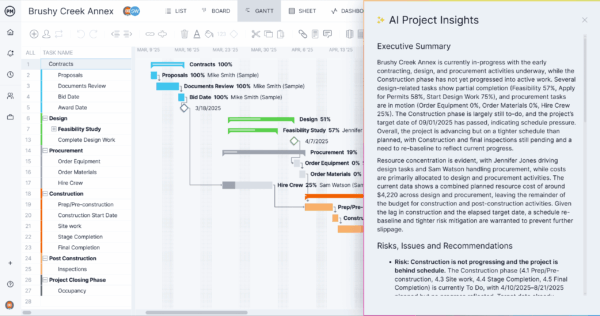
Digitalizing Communication and Documentation
Digital tools streamline communication, document storage and information sharing. Paperless workflows reduce errors, speed up approvals, and improve accountability.
Free Templates to Manage a Construction Company
Using templates saves time and ensures consistency across projects. Free templates provide frameworks for budgeting, invoicing and quotes.
Construction Budget Template
Download this free budget template to help plan expenses, track costs and maintain profitability across projects. It provides a structured framework for forecasting labor, material and equipment costs while identifying potential overruns early. By standardizing how budgets are created and reviewed, construction companies can improve financial accuracy and make better decisions when allocating resources.
Construction Invoice Template
Ue this free invoice template to simplify billing, improve cash flow and maintain professional records. It allows construction companies to issue clear, professional invoices that reduce errors and disputes. With a consistent format, payments are easier to track and clients have confidence in the accuracy of charges. Using an invoice template also saves time by streamlining the administrative process.
Construction Quote Template
This free quote template standardizes proposals, ensures accuracy and helps secure new clients. It outlines project scope, costs and timelines in a professional format that builds trust with clients. By presenting clear and consistent information, construction companies can win more bids while avoiding misunderstandings. Templates also speed up the process of responding to new opportunities, giving companies a competitive edge.
How to Manage a Construction Company With ProjectManager
ProjectManager offers multiple project views that make managing construction projects simple and efficient. Its Gantt charts provide a clear timeline of tasks and link dependencies to avoid cost overruns. Plus, it filters for the critical path to identify tasks with zero slack and can set a baseline to track progress in real time. Kanban boards allow teams to visualize workflows and track progress at a glance. With mobile access, teams can update progress from the field, making it easy to keep every stakeholder aligned and informed throughout the project lifecycle.
Need even more inspiration to improve your construction projects? Watch below to see how ProjectManager supports construction projects.
Streamline Resource Management
ProjectManager allows construction companies to allocate and manage resources efficiently. Teams can assign tasks to specific employees, track availability and balance workloads to prevent bottlenecks. Built-in tools monitor labor hours, equipment usage and material allocation, providing visibility into productivity and costs. This makes it easier to optimize schedules, reduce waste and ensure that the right resources are in the right place at the right time, which is essential for meeting deadlines and keeping projects on budget.
Improve Project Tracking
The software makes tracking progress and performance simple for construction managers. Dashboards provide real-time reporting, helping project managers stay on top of schedules, budgets and resource allocation. Task completion, milestones and timelines can be monitored in real time, while automated alerts notify teams of delays or overdue work. Timesheets and labor costs can be updated directly from the job site using the mobile app, keeping budgets accurate and current.
Detailed reporting powered by AI Project Insights and analytics gives managers insights into project performance, helping them make data-driven decisions, adjust plans quickly and maintain accountability across all teams and subcontractors.
Related Construction Managing Content
There’s more to managing a construction company than outlined above. For readers interested in learning more, check out the links below. They define different types of construction projects, methods and techniques, among other things.
- 10 Types of Construction Projects with Examples
- 18 Construction Methods and Techniques
- Construction Contingency: A Quick Guide
- Critical Path Method (CPM) in Construction: A Quick Guide
- 8 Free Construction Forms for Excel and Word
- 14 Types of Construction Contracts: Pros, Cons & Best Practices
ProjectManager is online project and portfolio management software that connects teams, whether they’re in the office or on the job site. They can share files, comment at the task level and stay up to date with email and in-app notifications. Get started with ProjectManager today for free.
The post How to Manage a Construction Company: 9 Key Areas to Manage appeared first on ProjectManager.
